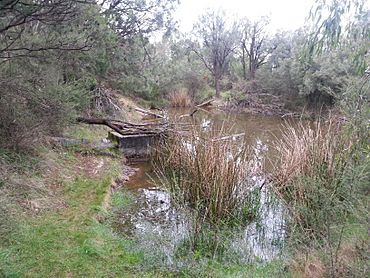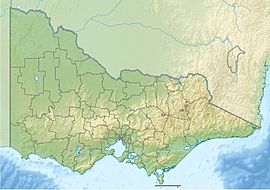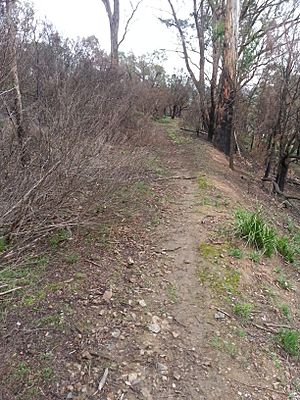Churchill National Park facts for kids
Quick facts for kids Churchill National ParkVictoria |
|
|---|---|
|
IUCN Category II (National Park)
|
|

The remains of aqueduct and pipeline, Churchill National Park.
|
|
| Nearest town or city | Lysterfield South |
| Established | 12 February 1941 |
| Area | 2.71 km2 (1.0 sq mi) |
| Managing authorities | Parks Victoria |
| Website | Churchill National Park |
| See also | Protected areas of Victoria |
The Churchill National Park is a special natural area in Victoria, Australia. It's part of the wider Greater Melbourne area. This national park covers about 271 hectares (that's like 670 football fields!). It's located about 31 km southeast of Melbourne, right next to a suburb called Lysterfield South.
Churchill National Park is close to the Monash Freeway and Stud Road, making it easy to visit. It's also connected to Lysterfield Park. Together, these two parks make up a huge natural space of 1668 hectares. They are a safe home for many native birds, mammals, and reptiles. They also offer great places for people to enjoy nature and outdoor activities.
The park was first created on February 12, 1941, and was called Dandenong National Park. In 1944, it was renamed Churchill National Park. This was done to honor Sir Winston Churchill, who was a very important leader during World War II.
Contents
Exploring Churchill National Park
Churchill National Park has many tracks for walking, cycling, and jogging. These paths let you explore the park's beautiful nature.
Walking and Cycling Paths
One popular path is the Channel Track. It's a very peaceful walk through thick woodland. This track runs right beside an old aqueduct, which used to carry water. The eastern boundary track is especially good for cycling and jogging.
Picnic Areas and Facilities
The park has a nice picnic ground. Here you can find gas barbecues to cook your food. There's also a unisex toilet and a shelter, which is handy if it rains. The picnic grounds are located at the end of the main access road.
Wildlife in the Park
Churchill National Park is famous for its amazing birds. It's home to 173 different kinds of birds! You might spot an Australian wood duck or a Pacific black duck near the dam. The dam is located along the northern boundary track.
Most mammals in the park are active at night. If you visit early in the morning or stay until late, you might be lucky. You could see animals like echidnas, wallabies, and kangaroos. Echidnas are also sometimes active during the day. They search for ants and grubs in the ground with their long snouts.
History of the Park
The land that is now Churchill National Park has an interesting past. It was once used by the police.
Police Paddocks and Early Use
For many years, this area was the headquarters for police who tracked people. It also provided grazing land for their horses. Because of this, it was known as the Dandenong Police Paddocks.
In the 1920s, the area started to change as nearby towns grew. Stone was dug up from the park to build roads and other structures. A channel was built to supply water to Dandenong. The State Electricity Commission also put power lines through the area. There were also fires and some clearing of the land.
In 1939, the area was officially set aside as Dandenong National Park. This was made official in February 1941. Later, in 1944, it was renamed Churchill National Park.
The Old Quarry and Tramway
In the northwest part of the park, you can find an old quarry. This is where stone was dug out of the ground. You can still see parts of the old tramway and the foundations of the crusher machine. This tramway was called the Scoresby Tramway.
The Dandenong Shire Council built the tramway in 1912. It was used to carry crushed rock from the quarry. The wagons mostly moved by gravity, rolling downhill on their own. When the ground became flat, horses were used to pull the wagons. The quarry only operated for about three years. After it closed, the tramway was removed.
See also
 In Spanish: Parque nacional Churchill para niños
In Spanish: Parque nacional Churchill para niños



